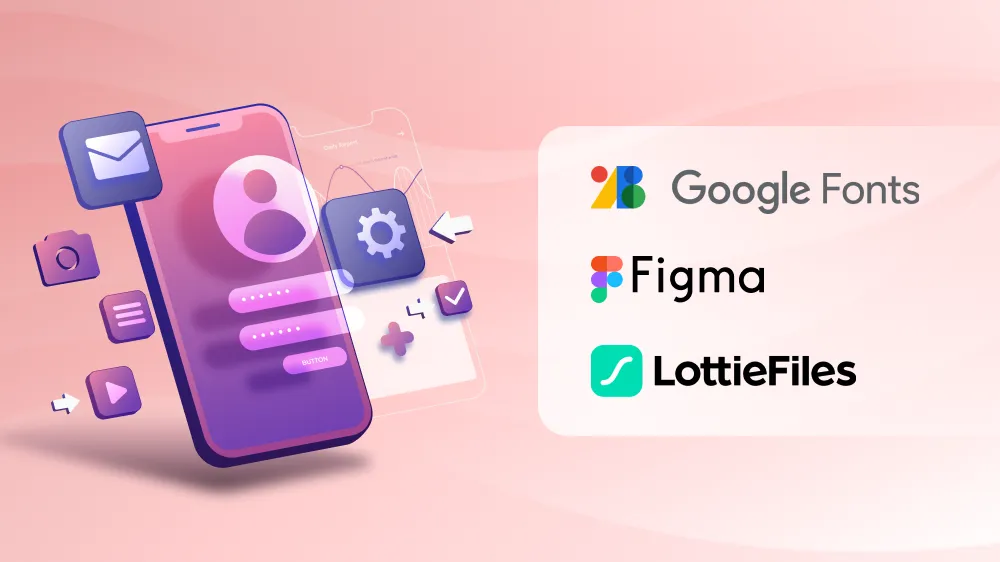
The Ultimate List of Front-End Development Tools for Success

Content Map
More chaptersHumans have learned how to utilize tools from the dawn of civilization. Spears and knives were used when hunting, hammers, and ladders were used for building, and later, we learned to invent and use machines to assist us with almost every process, be it big or small. In the realm of software development, there exists a wide range of intangible tools, such as frameworks, libraries, and testing tools, that are essential to the software development process. These tools play a critical role, much like how hammers and cement are crucial in the construction of a building.
The market demands are ever-changing, technology is developing in leaps and bounds, and new software applications are introduced near-daily. Hence, knowing which right frontend development tools turn a developer into a Superman. After all, tools empower its users. This article will outline every front-end development tool you need to know to acquire your superpower.
What Is Front-End Development?
Definition
Everything that appears on the screen and is visible to the user is part of front-end development. It is the process of giving a website or application structure, animation, and functionality life. The role of a front-end developer is to take the client’s vision and design concept and translate it into code, producing buttons, links, animations, logos, search bars, and general layouts. Frontend engineering is primarily concerned with the user experience, making sure that the interface is beautiful, simple, safe to use, and quick to load.
As a frontend developer, you’ll need a suite of essential tools, including frontend frameworks, JavaScript libraries, text editors, Integrated Development Environments (IDEs), version control systems, CSS preprocessors, performance optimization tools, and a variety of testing and design tools. We will go through all these tools in today’s article.
Consideration When Choosing Front-End Tools
Several considerations come into play when choosing the right tool. First, the tools and technologies need to align with the project and business goals while adhering to the industry’s standards and regulations. Next, think of your tech stack. For example, if your web development project uses HTML, CSS, or JavaScript, choose versatile tools like Selenium, Puppeteer, or Playwright. Third, think of the learning curve that is required for the chosen tools. This looks different for junior and senior developers, but do keep the timeline in mind, too. Last but not least, if you are still pondering, you can always give yourself and the team a trial period, collect feedback, and make adjustments as necessary.
Leading Front-End Development Tools by Category
Frontend Frameworks

Front-end frameworks are a must for front-end developers. They are prewritten codes that developers use to create the web interface or web app quickly, without writing codes from the beginning.
Vue.JS
Vue.js is the third most popular framework and the second most desired framework according to a 2023 Stack Overflow survey. Being lightweight and flexible, Vue.js is used for creating UIs and single-page applications (SPAs). The framework is beginner-friendly, easy to maintain and boasts a massive community.
Angular.JS
Another popular framework in the 2023 Stack Overflow 2023 survey, coming second in the popularity chart, Angular also applies a component-based architecture similar to Vue.js. The framework promotes code reusability, clarity, and conciseness in code presentation. Angular is often utilized to develop SPAs and enterprise-scale applications. Angular is often compared to Bootstrap, another popular front-end framework.
Tailwind CSS
With Tailwind CSS, users can construct applications more quickly and simply. It is a utility-first CSS framework. It doesn’t provide fully styled-components but offers users utility classes to create custom, reusable components. Although it is a lower-level CSS framework, it gives users great flexibility and control over the web application’s appearance and designs.
JavaScript Libraries

Another must-have tool for front-end web development is JavaScript libraries. JavaScript libraries are reusable code with a single primary use case, eliminating the need to reinvent code, enhancing development efficiency, and preventing errors.
jQuery
jQuery can be found on approximately 77 million web pages worldwide. jQuery, one of the most commonly used Javascript libraries, is preferred for condensing routine activities into short, cross-browser-compatible code. Some have compared it to a Swiss Army Knife for being such a feature-rich library that simplifies HTML markup, event handling, animating, and AJAX interactions for effective front-end web development.
React JS
Among the web development tools listed so far, React is the most well-known one. In the same Stack Overflow survey, React leads in both the popularity and most desired categories. Its ability to create basic views for each project state, encapsulating components for intricate user interfaces, and virtual DOM utilization are among the top reasons for its appeal. Compared to Angular or Vue, React’s performance reigns superior.
Integrated Development Environments (IDEs)
With Integrated Development Environments (IDEs), you can find a comprehensive suite of tools in one place. It often offers multiple functions like code completion, code compiler, debugger, code editor, etc. The tools and functions aim to enhance productivity and collaboration and simplify the web development process. Some IDEs focus on specific languages, e.g., Sublime for React developers, but most are compatible with multiple programming languages.
Version Control Systems
Version control systems help you keep track of and manage changes in the software code. This essential tool keeps you on top of the configurations when working in a team with multiple developers working on the code.
Git
Git is a top choice when it comes to version control systems. It holds a market share of 89.21%, and 100 million developers use it. It is lightning-fast and can handle both small and large projects with prioritization of data integrity and distributed, non-linear workflows.
Git is often confused with Github. While the two have distinct differences, it can be simplified by understanding that Git is a version control tool, whereas GitHub is a platform that facilitates collaboration.
Apache Subversion (SVN)
A second runner-up to Git is Apache Subversion, or SVN for short. It is a centralized version control system with a number of features like branching and merging, atomic commits, and user access restrictions.
Code Editors
Visual Studio Code
Developed by Microsoft, this free and open-source code editor is the top IDE in recent surveys. Despite being relatively new, it proves to be powerful with a number of features, including IntelliSense for smart code completion, built-in debugger, cross-platform language sources detection, integrated Git version control, and Live Code to enhance collaboration.
Sublime Text
Sublime text is an ideal choice for building an efficient and speedy user interface. The tool supports a broad range of plug-ins and simultaneous editing across multiple locations. But what makes it stand out is probably its wide choice of keyboard shortcuts, giving web developers quick access to the command menu.
Code Validator
A validator is a computer program that verifies if a document or piece of code is valid or syntactically correct. This tool comes in handy, particularly when one needs to check everything one more time before the official launch.
W3C Markup Validation Service
This is a tool that checks the HTML or XHTML code of a web page to see if it complies with the standards officially defined by the World Wide Web Consortium (W3C). With this service, developers ensure that their web pages are displayed consistently and correctly across different browsers and devices while also fixing errors in their markup.
CSS Preprocessors
Scripting languages known as CSS preprocessors allow CSS to do more than it does by default by letting developers write code in a more flexible, maintainable way, leading to the code being more organized, reusable, and easier to manage.
Less
Less (Leaner Style Sheets) entails features like next rules, variables, functions, and mixins, enabling developers to have richer and more extensive styling capabilities.
Sass
Sass, which stands for Syntactically Awesome Style Sheets, is a widely used CSS preprocessor. It facilitates the use of variables, functions, mixins, and nested rules and makes it easier to share designs across multiple projects.
Testing Tools
ESLint
Most developers use ESLint to analyze the source code. It is a tool that performs static analysis on JavaScript code to quickly spot issues, syntax errors, undeclared variables, or non-adherence to style guidelines, even before they run the application locally.
Selenium
Selenium is a recognized automation test tool. Exclusively for web-based applications, it supports multiple browsers, platforms, and languages. Selenium provides QA teams with a vast set of tools and libraries for automated browser automation and testing.
Design Tools

Google Fonts
This online, free-to-use font library consists of thousands of fonts for web page design. Typography is a subtle yet great way to enhance your visual user experience.
Figma
In addition to providing designers with an array of tools, e.g., animation, prototyping, and vector editing, to create appealing mobile and web applications, Figma also acts as a collaboration tool.
Lottie Files
Sometimes, static websites aren’t cut out to convey your business message. What better way than to use animations to create not only a responsive but dynamic website as well? Lottie Files offers a large number of free animations that you can customize to match your website’s theme.
Performance Optimization Tools
Did you know that the average load time for a website is 2.5 seconds? It is an acceptable time for users to wait to interact with any website. Hence, it is crucial to identify the bottlenecks and optimize your website’s performance to maintain a good conversion rate.
Lighthouse
Lighthouse is an open-source tool by Google that evaluates a website’s performance based on a number of criteria, including accessibility, performance, and SEO practice. The tool performs audits on these aspects and suggests aspects that can be improved. Not only does this boost your website’s speed, but it also enhances the chances of your web page being discovered on Google.
Final Thoughts
Technology is constantly evolving, and so is the toolkit that comes with it. It is crucial, however, to nail the most basic development tools as a front-end developer before moving on to the more novel ones. Many of these tools have stood the test of time for good reason.
This also makes it clear that the career of a software developer is not static. Continuous learning and skill refinement are necessary to remain competitive. A great way to achieve this is by working and growing in environments like Orient Software, where excellent mentors can help you progress faster. Our expert teams are equipped with all the important and more, so feel free to contact us and let us know what your next development project is!






